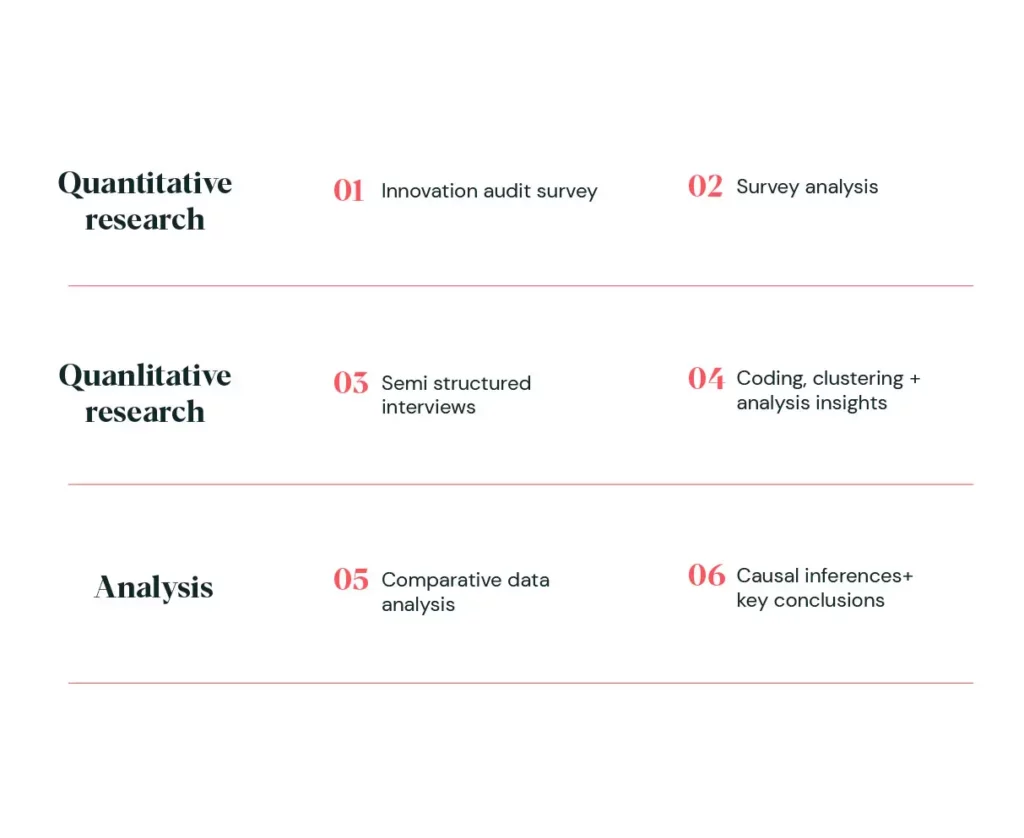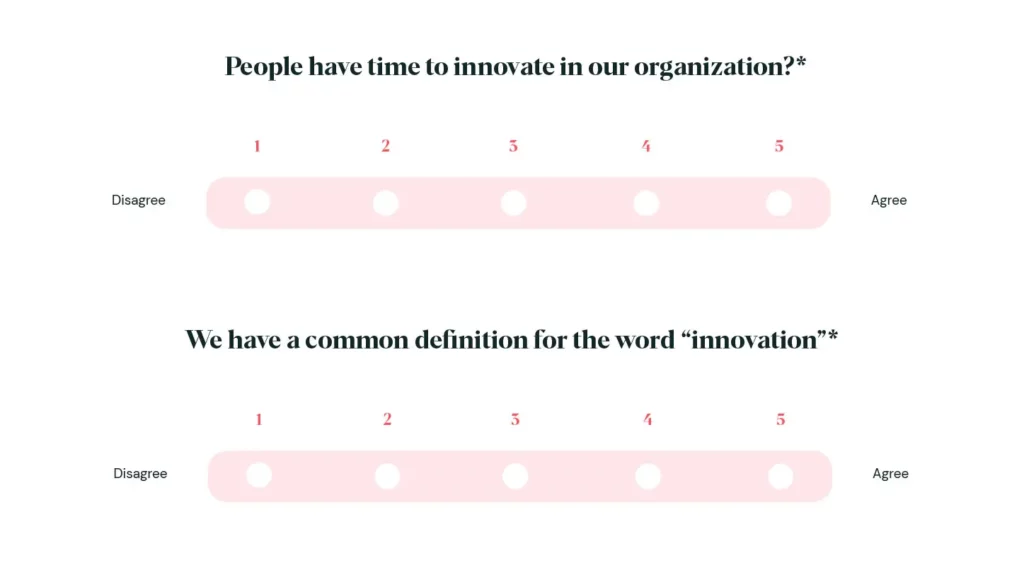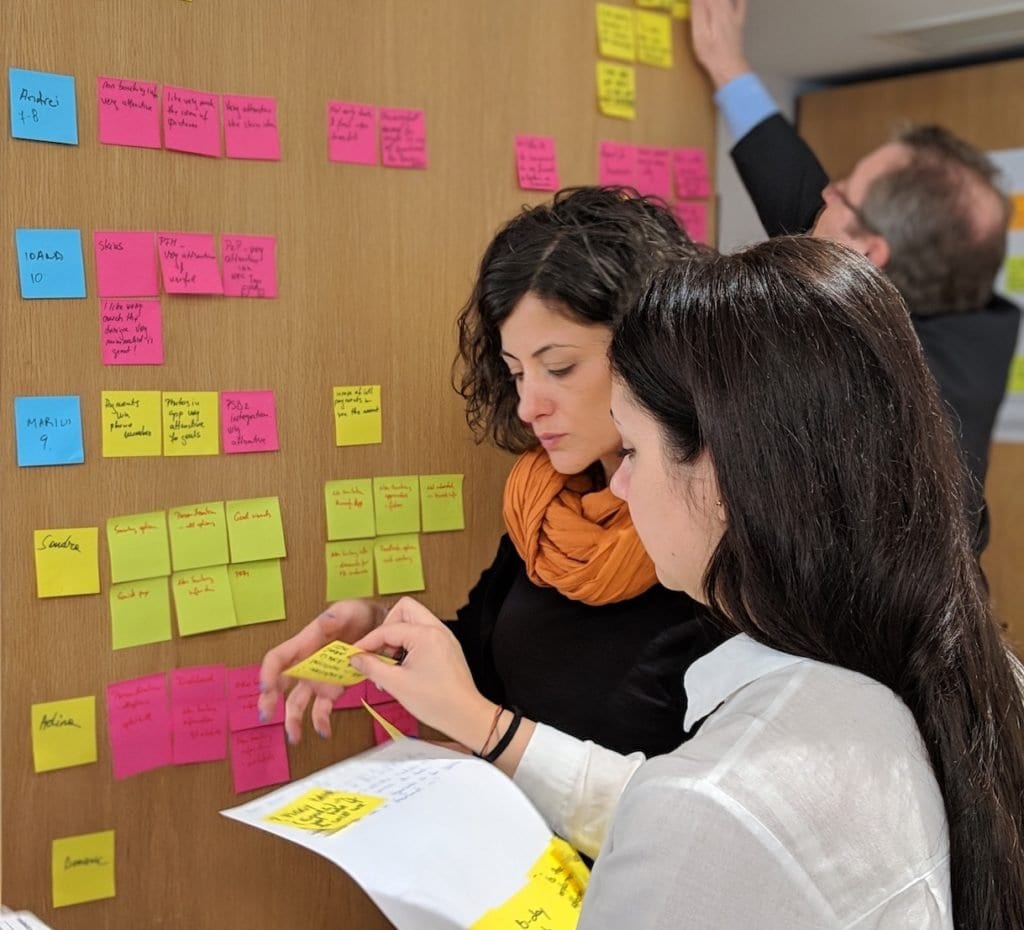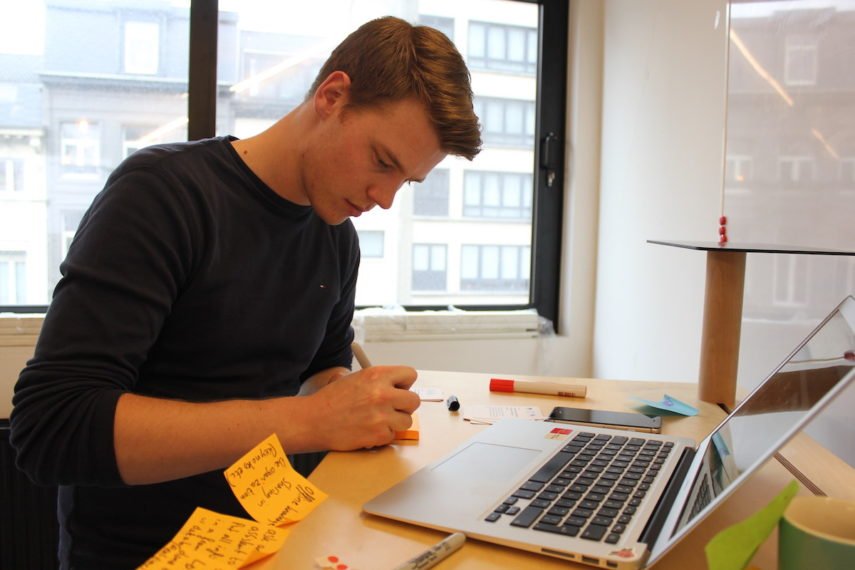"How are we doing with our current innovation capabilities?"
…We get this question a lot from c-suites and innovation managers around the World. They want to know how their organization is doing compared to other leading companies to help them understand how they can level-up their game.
The question might be crucial, but such framing doesn’t necessarily help. Rather than looking outwards at what other companies are doing, corporates should start by looking inwards when considering how to make their renewed innovation strategy more in-line with the evolving business environment.
What is an innovation audit?

The innovation audit process
An innovation audit is a way to understand how your organization is managing innovation, and recognize which parts of the funnel are working and where more effort is needed.
An innovation audit is a crucial step for an organization. It enables objective reflection and analysis from a third person view before executing programs to upgrade innovation capabilities that might not be well aligned with what is actually going on day to day.
Why do an innovation audit?
The purpose of an innovation audit is to understand the innovation process as-is and to avoid initiating and executing expensive and potentially unhelpful innovation strategies and programs.
Looking internally at how your organization is functioning in terms of innovation is one of the best ways to avoid wasting money (and time) and frustrating company employees. No one wants yet another change management fad with hazy goals that doesn’t really achieve what it set out to.
Looking inwards has two crucial advantages:
- Starting from data
Gathering insights from within the organization sets the ground for evidence-based decision making, rather than opinion about the way things should be. Collecting data also helps design a program tailored to organizational needs. Every company has a unique set of capabilities, processes, routines, knowledge, legacy and understanding about what innovation means and how they go about it. - Avoiding uninformed top-down mandates
To develop an effective innovation process, the voice of the employees must be taken into account from multiple perspectives. Think of it as Design Thinking applied to your own organization.
Unlock the power of AI in a unique sprint format. Leverage the latest AI tools to generate new ideas, get real-time feedback, and curate new concepts to move forward with.
How do innovation audits work?

First, we go broad
The research design process is tailored to each specific company context but generally we would start by compiling a quantitative survey that is sent out globally across departments and business units with the specific focus on elements of innovation capabilities. The goal here is to understand how innovation is currently configured and operating across the company in order to compare it later-on with insights gained via semi-structured qualitative interviews with c-suites and senior management who have broad visibility on the innovation process during project lifecycles.
During this phase, we aim to find out if there is a gap between how senior management portrays their strategic innovation intent vs. how this is working on a daily basis throughout the business.
Respondents are asked to state how much they agree or disagree with a particular statement across dimension such as: environment, governance, people, leadership and resources for innovation outcomes.
Once the data is in, it is possible to gain insights into employees, management and culture that currently surrounds and supports innovation capabilities.

Then, we go deep
We then organize interviews with c-suite and senior management across the company and its divisions. As mentioned above, the goal here is to dig deep into the perception top management has of the companys’ innovation capability, its process and outcomes.
In a recent case, we took just 30 mins to interview each participant based on four common themes:
- Current innovation capabilities
- Innovation project journeys
- Post-innovation project journeys
- Innovation cultural dimensions
These areas cover a range of organizational activities that underpin the innovation process and allow us to gain a high-level of understanding to uncover key insights through open-ended questions.
This in turn helps us deep-dive and uncover the elusive why’s that create potential barriers to innovation.
During the interviews, we take notes with Post-its and Sharpies to get clear and concise answers. The rule is: one idea or concept per post-it. That way, we can make sense of things when synthesizing and analyzing the data afterwards.
Client case study
Clustering
In a recent innovation audit we conducted, we analyzed and clustered data and insights gathered from the range of 1:1 interviews. Having all the info on Post-its helps jump-start into pattern recognition and clustering, something that would be much harder to do if the interviews were written down on paper or on a digital spreadsheet.
We then shared and read insights out loud whilst organizing them on large whiteboards to see which themes and clusters emerged.
This process of coding results in first and second order codes of the major underlying themes. We then look at the potential causal linkages that start to explain the relationships between insights across the innovation process. A sense of what is happening can soon be uncovered as to what is going on and why.*
* This process is based upon specific research design methods and paradigms. We ground our research approach in specific ontological and epistemological stances appropriate to help answer research question(s), aims and objectives. In this instance, we took a mixed methods approach with subjective > interpretivist > inductive > interview research paradigm for the bulk of the research.

Categorizing
Once clusters emerge, we synthesize into key themes. In a recent audit, nine categories emerged:
- Innovation strategy: the common definition of innovation among management and employees and how it relates to the company’s objectives
- Innovation status-quo: how the innovation process and funnel is currently handled
Culture & projects: how culture and individual personalities are driving decision making around innovation - Innovation types: what type of innovation is possible given the way the organization is currently configured to support it
- Resource allocation: how managers and teams decide to allocate people, time and resources to innovation projects
Business modelling: how the business modelling logic impacts current innovation outcomes
Strengths: what is currently working well regarding innovation execution - KPI’s: metrics used across all types of innovation (H1, H2, H3) and how it makes it difficult for more radical projects to move forward or even gain initial approval
- Decision making: how constraints (or boundedly rational managers*) influence which projects or ideas are killed off or given the green light
* Bounded Rationality is a concept proposed by Herbert Simon that challenges the notion of human rationality as implied by the concept of homo economicus. Rationality is bound because there are limits to our thinking capacity, available information, and time (Simon, 1991). Put simply, bounded rationality is the idea that we make decisions that are rational, but within the limits of the information available to us at time and our mental capabilities.
What's next?
Finding weaknesses
The challenges for innovation in our client’s innovation process were:
- Innovation strategy: there was a lack of a common understanding of innovation between management & employees
- Business modelling: the legacy business model logic was applied to innovation projects with existing quick-win, low risk outcomes that automatically killed-off anything potentially risky or innovative ideas
- KPI’s: the same metrics were used across all type of innovation (H1, H2, H3), making it very difficult if not impossible for more radical concepts to gain any traction
- Resource allocation: a focus on H1 projects and lean optimization made it difficult to free-up staff for H2 or H3 projects lasting longer than 18 months.
Next steps, are to organize an Innovation strategy sprint and define a simple Innovation mission map that is entirely aligned with the business objectives. This will ultimately enable a balanced portfolio of innovation projects (from incremental to radical) to be possible without killing-off riskier, potentially higher-reward outcomes.
Trouble with innovation? You're not alone
Every company has its unique cultural status-quo and typical blockages around innovation (or lack of it).
If you are an executive or innovation manager, this is where any conversation on levelling-up your innovation game should start in order to put your company back on the right path whilst avoiding potentially big wasteful mistakes.
Start small
Our innovation audit session lasts one day. Look inward and have a better, more objective understanding of how your company is currently supporting and driving. You can then confidently decide which parts of the innovation process need to be worked on most and what specific innovation program formats would make sense.
Let's collaborate!
Need support in setting up your innovation audit?
We are happy to guide you through the process.
References
Doss, Henry & Brett, Alistair. (2015). The Rainforest Scorecard: A Practical Framework for Growing Innovation Potential. Regenwald.
Rao, Jay & Weintraub, Joseph. (2013). How Innovative Is Your Company’s Culture? MIT Sloan Management Review.
Simon, Herbert (1991). “Bounded Rationality and Organizational Learning”. Organization Science. 2 (1): 125–134.


